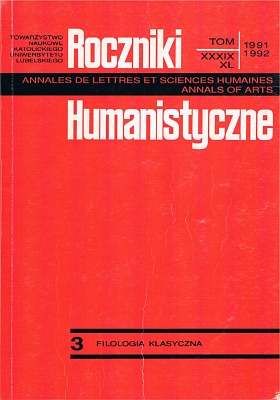Zakochani młodzieńcy w komediach Plauta
Abstrakt
The article discusses the differences that can be observed between Plautus’ various characters of this group. The literary analysis of selected scenes in which they take part makes it possible to conclude that Plautus’ young men are not merely the conventional figures they have traditionally been considered to be.
Valuable material is obtained from an analysis of the young men’s monologues, which reveal the attitudes and individual characteristics typical of each. But those characteristics are seen most sharply in situations that can be described as „the overcoming of obstacles to love”. As required by theatrical convention, in such circumstances the young men usually show themselves to be comically inept and have to fall back on the help of resourceful friends or slaves. Still, most of the young men try to solve the accumulating difficulties through their own ingenuity and active participation in the intrigue. This is an important criterion distinguishing between Plautus’ young lovers.
The characterization is complemented by a set of situations connected with what is the frequent result of amorous adventures: the loss of property. While this motif comes to the fore in just two comedies, Trinummus and Mostellaria, it is also frequent enough in the monologues. The young heroes also differ with regard to matrimonial complications, since marriage does not always appear in Plautus’ comedies as a punishment for youthful peccadilloes; indeed, it often constitutes the happy ending of romance. In most Plautine comedies love for a hetaera and the young man’s efforts to free and marry her are the main motifs, but there are also cases where the daughter of a free citizen is the object of love.
The article ends with short characteristics of the individual young men in love and the conclusion that in spite of all the simplifications due to Plautus’ contamination technique and to the requirements of Greek New Comedy the lovers differ as regards their personality and degree of involvement in the dramatic action.
Copyright (c) 1992 Roczniki Humanistyczne

Utwór dostępny jest na licencji Creative Commons Uznanie autorstwa – Użycie niekomercyjne – Bez utworów zależnych 4.0 Międzynarodowe.





